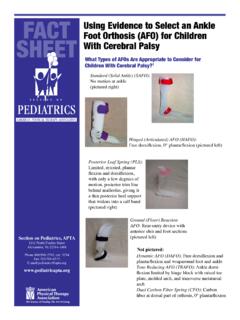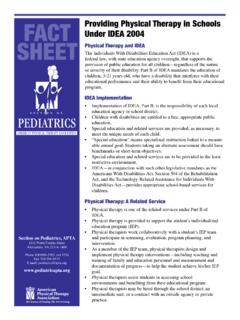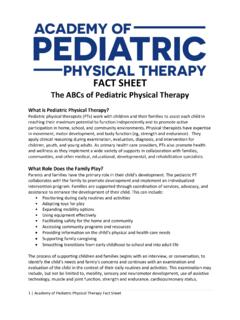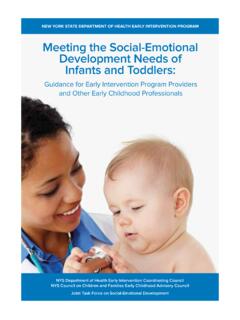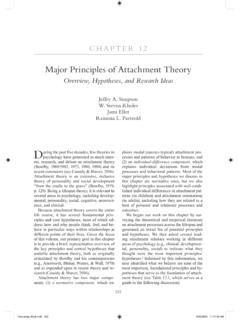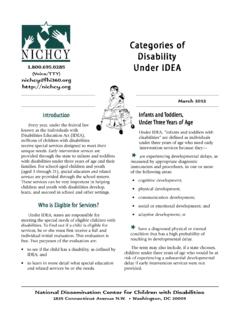Transcription of The Role of Physical Therapy with Infants, Toddlers, and ...
1 The Role of Physical Therapy with Infants, Toddlers, and their Families in Early Intervention AMERICAN Physical Therapy ASSOCIATION SECTION ON PEDIATRICS EARLY INTERVENTION SPECIAL INTEREST GROUP Who are Physical therapists? Physical therapists help individuals improve or restore mobility and prevent or manage health conditions. Physical therapists use interventions to help individuals move, reduce pain, restore function, prevent disability, and promote wellness and participation in life. What type of educational background do Physical therapists have? Education in conditions affecting the following systems: Musculoskeletal (muscles and bones) Neuromuscular (nerves and muscles) Cardiopulmonary (heart and lungs) Integumentary (skin and tissues) What credentials do Physical therapists have?
2 Degree from an accredited Physical Therapy program at the college or university level The American Physical Therapy Association (APTA) has a vision that by the year 2020, Physical Therapy will be provided by Physical therapists who are doctors of Physical Therapy . Licensure for Physical Therapy practice Each state has their own licensing requirements and Practice Act governing what a Physical therapist can do. Where do Physical therapists provide services? A variety of settings: Hospital Out-patient Home School Other community settings What is Early Intervention? Early intervention supports the needs of infants and toddlers with developmental delays and disabilities and their families. Early intervention is a program supported by federal legislation. Individuals with Disabilities Education Act (IDEA) Part C of 2004 (Public Law 108-446) What is IDEA Part C?
3 A federal law, assisting states to provide a comprehensive, coordinated, multidisciplinary, interagency system for services for infants and toddlers with delays and disabilities and their families. Where are Early Intervention services under IDEA Part C provided? In natural environments where children live, learn, and play, such as: Home Child care Early Head Start Community settings What services can be provided under Early Intervention? Family training, counseling, home visits Special instruction Speech-language pathology & audiology services, and sign language & cued language services Occupational Therapy Physical Therapy Psychological services Service coordination Medical services only for diagnostic or evaluation purposes Early identification, screening.
4 And assessment services Health services necessary to enable the infant or toddler to benefit from the other EI services social work services Vision services Assistive technology devices and services Transportation and related costs necessary to receive early intervention services What is the focus of Early Intervention services? To enhance the development of infants and toddlers: Physical development Cognitive development Communication development social and emotional development Adaptive development To enhance the capacity of families to meet the special needs of their infants and toddlers Who can refer a child to Early Intervention? Parents or legal guardians Health care professionals Community child care providers Who is eligible for Early Intervention?
5 Children from birth to three years of age who: are delayed in their development have a diagnosis of a Physical or mental condition that can result in a developmental delay Eligibility is determined through evaluation and assessment. Specific eligibility criteria varies from state to state. How is the Early Intervention evaluation and assessment conducted? The family and other EI team members collaborate on the process. Information is gathered through: Dialogue to identify family strengths, resources, concerns, preferences, and priorities Observation of daily routines such as play and feeding Synthesis of findings from various tests and measures to evaluate the child s development in the following areas: Physical , cognitive, communication, adaptive and social or emotional What is the Individualized Family Service Plan (IFSP)?
6 Written plan to guide the delivery of Early Intervention services for eligible children and their families Developed collaboratively as a result of the evaluation and assessment process Identifies family s desired outcomes for their child Indicates type of services to help them meet goals Who gets Physical Therapy in Early Intervention? Based on the evaluation and IFSP, the team identifies which children benefit from Physical Therapy services. Physical Therapy may be a component of Early Intervention services for eligible children. What is the role of Physical Therapy in Early Intervention? Physical Therapy is a primary service in early intervention. Physical therapists work collaboratively as members of a team. Physical therapists are service providers, consultants, and can be service coordinators.
7 What is the focus of Physical Therapy in Early Intervention? Physical Therapy helps families with their child s development and ability to participate in age-appropriate and meaningful activities with families, friends, and neighbors. Physical therapists use their knowledge and skills specifically related to motor and self-care function, assistive technology, and medical/healthcare science to provide a unique contribution to the team. What are examples of Physical Therapy in Early Intervention? Physical Therapy helps children: learn to crawl so they can move from place to place, get to their toys or follow their parents around the house. learn to sit so they can play on the floor with their siblings and friends. improve balance so they can walk on the grass or in the sand without falling.
8 Get stronger so they can keep up with their friends. be fit so they can be active with their friends. hold, explore, and play with toys of different sizes, shapes, and weights. Physical Therapy helps children develop coordination so they can run, climb, slide or jump in their backyard or local park Physical Therapy helps children learn how to hold objects to build, create, and participate in self-care activities. What are examples of Physical Therapy in Early Intervention? Physical Therapy helps families: understand how to meet their child s needs create opportunities for their child to develop motor abilities find resources in their community that are suited to meet their needs transition their child to preschool or other community programs Physical Therapy helps families make decisions on adaptive equipment when and if needed by the child Who pays for early intervention services?
9 There are multiple sources that contribute to funding Early Intervention services. These include: Federal funds State funds, including Medicaid Family s personal insurance and co-payment The levels of funding from each source vary in each state. Where can I learn more about early intervention? Comprehensive information about EI The Early Childhood Technical Assistance Center: Resources for PT in EI APTA Section on Pediatrics website How can we help you? Contact the Section on Pediatrics of the APTA: 800/ 999-2782 x3254 References Chiarello L. Serving Infants, Toddlers, and Their Families: Early Intervention Services under IDEA, 944. In Campbell SK, Palisano RJ & Orlin, MN. (eds): Physical Therapy for Children. ed 4, 2012, Elsevier, St. Louis. McEwen IR.
10 Providing Physical Therapy Services Under Parts B & C of the Individuals With Disabilities Education Act (IDEA). Alexandria, VA: Section on Pediatrics, American Physical Therapy Association; 2008. American Physical Therapy Association: Guide to Physical Therapist Practice, Second Edition. 2003. Alexandria, VA. US Department of Education: Building the Legacy IDEA 2004 (can be accessed at ). Public Law 108-446, Individuals with Disabilities Education improvement Act of 2004, 118 STAT. 2647-2808 (can be accessed at ). Section on Pediatrics, American Physical Therapy Association, Early Intervention Special Interest Group.


